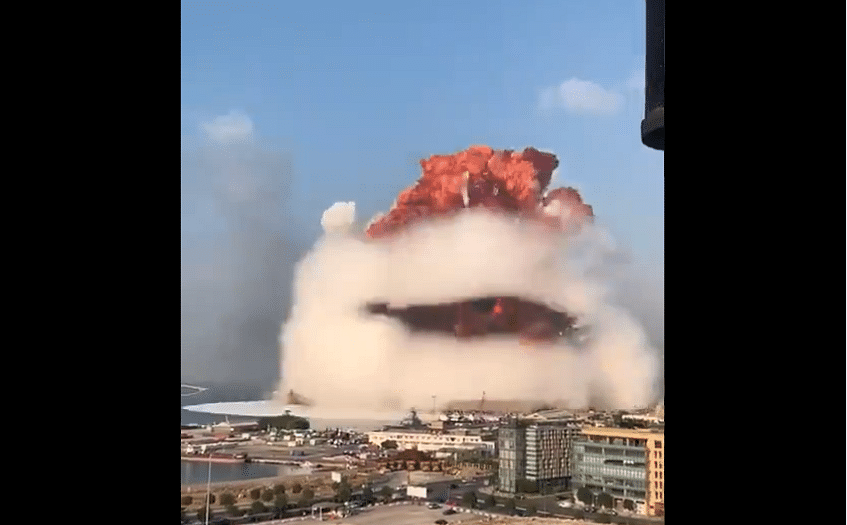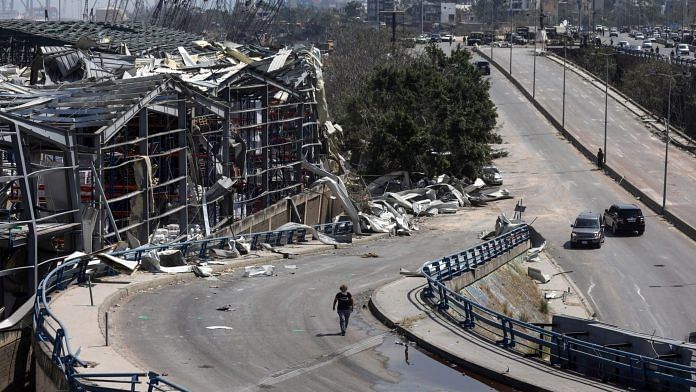New Delhi: The catastrophic blast in Lebanon’s capital city Beirut Tuesday left at least 135 people dead and over 4,000 injured.
The explosion was so powerful that it reduced massive sections of the city to debris and was felt all the way till Cyprus, which is more than 150 km away from the blast site.
According to Lebanese President Michel Aoun, the blast was caused by thousands of tonnes of ammonium nitrate. About 2,750 tonnes of the chemical, stored improperly in a warehouse in the city’s port, caught fire and exploded.
The ammonium nitrate had reportedly been impounded from a Russian cargo ship six years ago.
Here is a lowdown on what is ammonium nitrate and how hazardous it is.
Also read: Lebanon officials ignored warnings on ammonium nitrate behind deadly Beirut blast
What is ammonium nitrate?
Ammonium nitrate (NH4HNO3) — a white, water-soluble substance — is the main source of fertilisers and is also a popular industrial explosive.
Made up of nitric acid and ammonia, it is an oxidiser. An oxidiser increases the oxygen level that helps accelerate the combustion of substances.
While ammonium nitrate does not combust on its own, it can explode if it is contaminated by a flammable substance like oil or if it comes in contact with fire.
Since the chemical does not burn on its own, experts believe the explosion in Beirut could have been a result of poor maintenance practices or contamination.
Some other reports suggest that fireworks may have triggered the explosion.
Anthony May, a retired explosives investigator for the US government, told CNN that the amount of explosives and the shockwaves created by the blast “is typical of what would be equivalent to a kiloton nuclear bomb going off as far as the explosive weight is concerned”.
What causes ammonium nitrate to explode?
If the storage facility, where the chemical is kept, does not have adequate ventilation to allow quick dispersion of heat and toxic gases, it can cause dangerous explosions.
At high enough temperatures, ammonium nitrate can begin decomposing on its own. This process creates gases including nitrogen oxides and water vapours — this rapid release of gases can generate enough heat to cause an explosion.
As it burns, ammonium nitrate goes through chemical changes that lead to the production of oxygen, which causes the fire to get bigger. With no place to escape in a sealed container, it triggers a massive explosion.
The explosion of ammonium nitrate also releases nitrogen dioxide, which has a bad smell and lends a characteristic red colour to the smoke emitted. This red smoke is visible in many of the videos of the Beirut explosion being circulated on social media.

The leftover nitrogen dioxide also poses a health hazard to residents in Beirut, till it dissipates naturally in a few days.
Ammonium nitrate was first discovered by German chemist Johann Rudolf Glauber after he combined ammonium carbonate and nitric acid in the seventeenth century.
However, it was German scientist Fritz Haber, also known as the father of chemical warfare, who found a way to produce it artificially through a process called the Haber process. He won the Nobel Prize in Chemistry in 1918 for this method.
Also read: World’s dilemma after Beirut – How to help Lebanon without empowering its shady rulers?
Past incidents of ammonium nitrate explosion
Ammonium nitrate has caused various explosions over the years.
One such explosion was at a fertiliser plant in the state of Texas in the US in 2013. The explosion had killed 15 people.
Another explosion occurred at a chemical plant in France’s Toulouse in 2001 that led to 31 deaths.
Recently, in 2015, an explosion took place in Tianjin in Northern China, when a highly flammable chemical self-ignited along with ammonium nitrate, killing 173 people.
Ammonium nitrate has also been used in explosive devices for acts of terrorism.
An attack in Oklahoma City, US, in 1995 that left 168 people dead, and the bombings that occurred in Indonesia’s Bali in October 2002 that killed 202 people involved the use of ammonium nitrate.
It is also a key ingredient in the improvised explosive devices (IEDs) of the Taliban, and has been used in many terror attacks.
In India, the 2011 Mumbai blast, the 2013 Hyderabad blasts, the 2011 Delhi blast and many other such attacks used ammonium nitrate mixed with other fuels.
The chemical was declared a special category explosive in December 2008 under the Explosive Substances Act.
Later, a government order in July 2011 declared it an explosive and made it mandatory to obtain a licence for its manufacture, storage and transport.
Also read: Why Hezbollah will not escape blame for deadly chemical blast in Beirut







Ammonium Nitrate and Fuel Oil (ANFO) is a standard blasting material in place of dynamite or TNT. Ease of handling is the key reason on ANFO use.